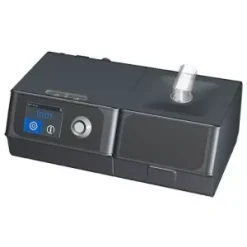What is BiLevel Positive Airway Pressure (BiPAP)?
BiLevel Positive Airway Pressure (BiPAP) is a non-invasive ventilation therapy specifically designed to assist individuals experiencing breathing difficulties. Notably, it delivers two distinct levels of air pressure—one for inhalation (IPAP) and a lower pressure for exhalation (EPAP). Consequently, this dual-pressure system plays a vital role in keeping airways open, thereby making breathing significantly easier and more efficient.
How Does BiPAP Work?
To begin with, BiPAP machines utilize a mask that connects to a device responsible for regulating air pressure. Unlike CPAP (Continuous Positive Airway Pressure), which maintains a single constant airflow, BiPAP, on the other hand, alternates pressure levels in sync with the patient’s natural breathing cycle. As a result, it offers a more comfortable and adaptive experience for individuals with respiratory challenges.
Key Functions of BiPAP Therapy:
- Inhalation Pressure (IPAP): Provides a higher pressure level to facilitate better airflow intake.
- Exhalation Pressure (EPAP): Delivers a lower pressure, making it easier to breathe out.
- Auto-Adjusting Features: Many BiPAP devices intelligently adapt pressure settings based on real-time breathing patterns, thereby ensuring optimal support.
Who Needs BiPAP Therapy?
BiPAP therapy is particularly beneficial for individuals dealing with a variety of respiratory conditions. Specifically, it is commonly prescribed for those with:
- Obstructive Sleep Apnea (OSA): Helps in keeping the airway open throughout sleep, preventing interruptions.
- Chronic Obstructive Pulmonary Disease (COPD): Assists in oxygen intake while simultaneously reducing carbon dioxide buildup.
- Central Sleep Apnea (CSA): Plays a crucial role in stabilizing irregular breathing patterns.
- Respiratory Conditions: Frequently used for conditions such as asthma, pneumonia, and neuromuscular disorders.
- Congestive Heart Failure (CHF): Helps manage respiratory distress caused by heart-related complications, thereby improving overall breathing.
Benefits of BiPAP Therapy
There are several advantages associated with using BiPAP machines, particularly for individuals facing breathing challenges. Some of the most significant benefits include:
- Enhanced Oxygen Flow: Ensures better oxygen exchange within the lungs, thereby promoting efficient respiration.
- Reduced Breathing Effort: Facilitates easier breathing, especially for individuals with weakened respiratory muscles.
- Improved Sleep Quality: Significantly minimizes interruptions caused by apnea episodes, leading to more restful sleep.
- Customizable Pressure Levels: Offers flexible settings tailored to meet individual needs, thus ensuring maximum comfort.
- Lower Risk of Hospitalization: Aids in managing chronic respiratory conditions at home, thereby reducing frequent medical visits.
BiPAP vs. CPAP: What’s the Difference?
| Feature | BiPAP | CPAP |
|---|
| Pressure Levels | Two (IPAP & EPAP) | One Constant Pressure |
| Best for | Severe sleep apnea, COPD, respiratory disorders | Mild to moderate sleep apnea |
| Exhalation Comfort | More comfortable due to reduced exhalation pressure | Some users find it harder to exhale |
| Advanced Settings | Auto-adjusting pressure options available | Fixed or auto-adjusting models |
Choosing the Right BiPAP Machine
When selecting a BiPAP machine, it is essential to take multiple factors into account. These include:
- Pressure Settings: Adjustable IPAP and EPAP levels for personalized therapy.
- Humidifier Features: Helps in reducing dryness and irritation, thereby enhancing comfort.
- Mask Compatibility: Ensures a secure and comfortable fit, preventing air leaks.
- Noise Level: Opting for a quieter machine improves sleep quality, making the experience more pleasant.
- Portability: Lightweight models offer added convenience, particularly for frequent travelers.
Conclusion
In summary, BiPAP therapy serves as a crucial tool for managing conditions such as sleep apnea, COPD, and other respiratory disorders. Thanks to its dual-pressure system, it provides a more natural and comfortable breathing experience, ultimately enhancing oxygen intake and sleep quality. If you experience difficulty breathing or frequent sleep interruptions, it is highly advisable to consult a medical professional to determine whether BiPAP therapy is the right solution for you.


